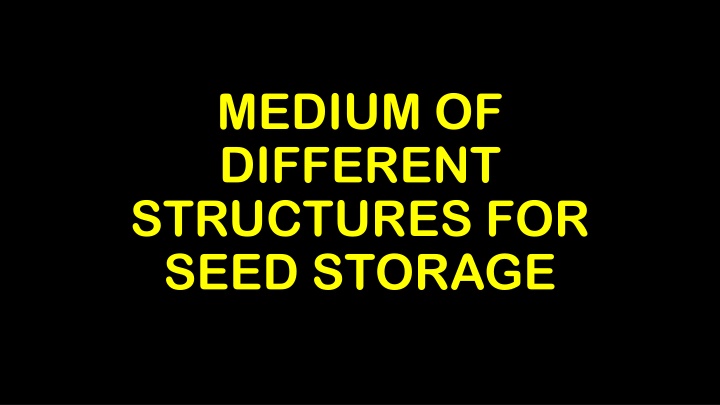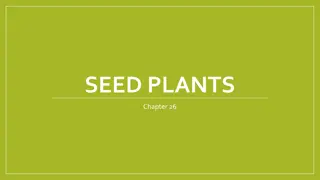Various Structures for Seed Storage and Improved Rural Storage Methods
Different structures like Bitumen/Coal Tar Drum, Hapur Bin/Kothis, Udaipur Bin, Stone Bin, and Bamboo Bin are highlighted for seed storage. Improved rural-level storage structures including metal bins and clay bins are also discussed, offering cost-effective and efficient options for preserving food grains. These storage solutions cater to the needs of small farmers and provide insights into modern storage technologies developed by institutions like the Indian Grain Storage Institute.
Download Presentation

Please find below an Image/Link to download the presentation.
The content on the website is provided AS IS for your information and personal use only. It may not be sold, licensed, or shared on other websites without obtaining consent from the author.If you encounter any issues during the download, it is possible that the publisher has removed the file from their server.
You are allowed to download the files provided on this website for personal or commercial use, subject to the condition that they are used lawfully. All files are the property of their respective owners.
The content on the website is provided AS IS for your information and personal use only. It may not be sold, licensed, or shared on other websites without obtaining consent from the author.
E N D
Presentation Transcript
MEDIUM OF DIFFERENT STRUCTURES FOR SEED STORAGE
IMPROVED RURAL - LEVEL STORAGE STRUCTURES 1) Bitumen/ coal tar drum 6) Baked clay bin 2) Hapur bin/ Kothis 7) PKV bin 3) Udaipur bin 8) The "Pusa" bin. 4) Stone bin 9) Pusa Cubicle 5) Bamboo bin 10) Pusa Kothar 11) Metal bins
BITUMEN/ COAL TAR DRUM An alternate model of metal bin, low cost with similar technical performance. These bins are of 520 mm dia and 900 mm height. They can store 1.5 q of wheat 1. Bitumen/ coal tar drum and 1.2q of Bengal gram. It was developed at the Central Institute of Agricultural Engineering (CIAE) and compares very well with other metal structures.
HAPUR BIN/ KOTHIS The Indian Grain Storage Institute, which is engaged in the development and dissemination of advances in storage technology to users, has developed metal bins for domestic storage of food grains 2. Hapur bin/ Kothis Circular bins of 2, 5, 7.2 and 200-100kg ( 10 q) capacities and have potential to meet requirements of even large farmers.
UDAIPUR BIN 3. Udaipur bin These bins are made out of used coal tar drums. These can stock 1.3 q of wheat and maize. These bins can be made to have more airtight lid if the drum outlet end is given small cut to unload the bitumen. These bins are suitable for storing of food grains for short duration and can be adopted by small farmers.
4. Stone bin Stone bin (Chittore bin) is made of locally available 40 mm thick stone slabs with dimensions of 680 mm x 1200 mm with square cross-section. The inlet and outlet are made of asbestos. This bin has a capacity of 3.8 q. 5. Bamboo bin These bins are made of two walls of bamboo with polythene lining in between and have varying capacities. These bins are suitable for short duration storage and can be adopted by small and marginal farmers.
BAMBOO BIN 6. Baked clay bin Baked clay bin of 7q capacity (paddy) is made of 16 burnt rings jointed by mud plaster; cement mortar and cow dung coatings one after another. The ends of the rings are made in such a manner that they fit into each other. These rings are kept on a polythene sheet covered and plastered platform of brick mansory and cement sand mortar. An outlet is provided for the discharge of the grain. The top is covered with a mild steel lid. Because of the low cost and good performance these are particularly useful for small and marginal farmers. Do not store their produce for longer duration.
PUSA BIN (IARI) . Developed by the Indian Agricultural Research Institute (I.A.R.I.); they are 8.The Pusa binP rectangular in shape and have a capacity of 1 to 3 tonnes. The "Pusa" bin has been widely adopted in India, and has been demonstrated in some African countries. It gives good results when loaded with well dried grain
This is a room like structure ( 3.95 x 3.15 x 2.60 m), a modification of Pusa bin to provide large storage capacity of 24 tonnes on a platform of 3.73 m x 2.93 m x 0.07 m is made with unburnt bricks on a concrete floor (except 22 cm of outer sides with burnt bricks). A polyethylene sheet is placed on this platform and another platform of similar dimension is made with unburnt bricks. The 22 cm thick inner walls are constructed upto 2.6 m height. A wooden frame of 1.89m x 1.06 m for door is fixed in the front side of 3.95 m wall. The roof can be made by wooden beam placed at 15 cm distance and covered with unburnt bricks.
PUSA KOTHAR 10. Pusa Kothar Presently storage is practiced in small compartments of a room (5.3 m x 2 m x 4 m) called kothar. The roof is constructed with the help of wooden poles and mud slabs, leaving near the front wall three filling holes each of 0.5 m x 0.5 m size. Two out lets of G.I. sheets of 15 cm dia. and 30 cm length are fitted at the floor wall on the front side.
11. Metal bins Bins made of steel, Aluminium R.C.C are used for storage of grains outside the house. These bins are fire and moisture proof. The bins have long durability and produced on commercial scale. The capacity ranges from 1 to 10 tonnes. Silos are huge bins made with steel/ aluminium or concrete. Usually steel and aluminium bins are circular in shape. The capacity of silo ranges from 500 to 4000 tonnes. A silo has facilities for loading and unloading grains.
ALTERNATIVE STORAGE TECHNOLOGY AT FARM/VILLAGE LEVEL Metal or Plastic Drums Drums are often used as storage containers in the house and serve notably for the storage of cereal seeds and pulses. Plastic drums are used intact or after having the upper part cut off to facilitate loading and unloading. Otherwise, plastic lends itself poorly to adaptation because it is relatively weak: at most, a lockable outlet can be added. If the lid is tight fitting and the drum is completely filled with grain, any insects present will deplete the oxygen in the drum and die.
Metal drums can be adapted for domestic grain storage in a similar way. A removable lid permits easy loading; but it is also possible to weld half of the lid to the rim of the drum, and provide a riveted hinge on the remaining half of the lid so that it alone can be opened. Fitted with a padlock, such a modified drum is more secure. To make a store of greater capacity, two metal drums can be welded together end to end and fitted out as described above. Well modified and/or fitted with gaskets, metal drums can also be made airtight.
Inaccessible to rodents, efficient against insects, sealed against entry of water, drums make excellent grain containers. However, they should be protected from direct sunshine and other sources of heat to avoid condensation by being located in shaded and well ventilated places.
Alternative Solid Wall Bins (i) The "Burkino" silo Based on a traditional dome shaped type of bin, this silo is constructed with stabilised earth bricks. Various models and capacities are available. The base is made of stabilised earth resting on the ground or on concrete pillars. The dome-shaped roof is also made of stabilised earth bricks, using special wooden formers. The technique of making a dome-shaped roof is not easy to master, and usually has to be done by skilled masons. A variant has been developed with the roof resting upon a wooden frame, which can be erected by unskilled farmers
(ii) The "USAID" silo This silo is based on the "Burkino" silo and examples have been erected in Nigeria; holding one tonne of maize grain, the silo rests on stone or concrete pillars supporting a reinforced concrete slab 1.5 metres in diameter. The walls are made of stabilised earth bricks and are plastered inside and out with cement reinforced with chicken wire mesh. The top is dome shaped with a central round opening, and covered with a cone-shaped earthen cap. This is plastered with cement, and rests on bamboos or on a metallic drum base. An outlet door, consisting of a 15 x 30 cm plate 1.5 mm thick which is smeared with grease for easy sliding, is let into the base concrete slab.
(iii) Concrete/cement silos Such silos are 'cement rich', and often include other materials which normally have to be imported into developing countries. Therefore they are potentially (and usually) expensive structures, which can be seriously considered only when improvements to traditional storage bins cannot be practically applied. Their redeeming feature, given that they are properly constructed and used, is that they are robust and should give many years of satisfactory service.
(v) Metal Silos Economically valid for storing large quantities (over 25 tonnes), metal silos are often regarded as too costly for small scale storage. Nevertheless certain projects have been successful in introducing small metal silos, of 0.4 to 10 tonne capacity, at farm/village level in developing countries.
(vi) Synthetic Silos Various develop small scale storage bins, using synthetic materials such as butyl rubber (O'Dowd, 1971) polyethylene (CFTRI, 1975). attempts have been made to and high density However, such bins proved to be either too expensive or prone to damage by pests. Also the management level required by such storage facilities is probably too high for most rural situations.
Conclusion Traditional storage structures need to be improved scientifically. Intensive research is required to evolve modern storage structures suitable to different agro-climatic conditions of India. State and central government agencies should possess temporary storage structures to handle bulk grains without any loss and damage.























